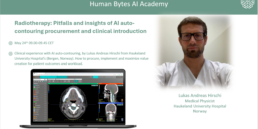Introduction
TheraPanacea’s devotion to help accelerate radiotherapy (RT) workflow through AI-based products has been well in line with the big range of ongoing clinical studies and projects under development. A total of 13 abstracts have been accepted at ESTRO 2023 that are demonstrating the feasibility of using ART-PlanTM modules and future developments for different steps of the RT treatment planning, including now the possibility of enabling offline adaptive RT.
MR/CBCT based synthetic CT generation
The majority of the studies (K. Shreshtha et al: PO-2337, PO-2350; T. Roque et al: PO-2348, MO-0389, PO-2351, PO-2358, A. Roussel et al: PO-1828) are related to adaptive treatment and to the ability to generate AI-based synthetic CT (sCT) from MR images (brain and pelvis) and from CBCT images (pelvis). One of the studies (A. Roussel et al: PO-1828) demonstrated through both image and dosimetric analysis that AI-based sCT can be clinically used for MR-only radiotherapy workflows in the pelvic and brain regions. At the same time, a step towards automation of the adaptive workflow was achieved by demonstrating clinical acceptability of AI-based organ contouring on sCT images from CBCT. These results can help unlock the ultimate goal of online, planning CT-less adaptive RT workflows.
Organ propagation
The use of the sCT from CBCT images was investigated for image registration and organ contouring propagation purposes (T. Roque et al: PO-2358) as part of offline adaptive tools. Overall, results showed that experts preferred the contours propagated through deformable registration from planning CT to sCT compared to traditional propagation from planning CT to CBCT images. This provides evidence for potentially replacing the CBCT-based patient daily positioning with sCT images that can further allow daily dose tracking and aid in decision-making process for replanning.
Automated plan optimization
Furthermore, a plan optimization approach based on dose mimicking was shown to reproduce clinically acceptable doses for prostate planning without manual interaction from the planner (R. Vauclin et al: PD-0977). These efforts aid to reduce the time-consuming task of manual planning and enable more efficient workflows in RT departments. While computational time remains a limitation particularly for online adaptive protocols, an experiment has been successfully conducted for accelerating Monte-Carlo dose simulations using neural networks (S. Martinot et al: PO-1802 ).
3D CT image generation
Through another study, the power of generating realistic 3D CT images using deep learning (style GAN) was demonstrated for head and neck anatomy (A. Cafaro et al: PO-1649). These findings have considerable impact for the research community due to capability for data augmentation as well as the potential of replacing the dose simulations on physical phantoms to that on artificially generated realistic images that can cover a larger range of anatomical representations. In only 30 sec, this network was able to generate full 3D CT image reconstructions from only 2D projections (A. Cafaro et al: OC-2240). It was shown that compared to patient positioning based on 3D CBCT imaging, the same level of accuracy was achieved by using the reconstructed images obtained from 100 times less projections. These results open doors for replacing the need of CBCT imaging for patient positioning.
Radiology learning from histology
Additionally two studies (A. Leroy et al: OC-0448, MO-0714) aimed at exploring AI power to bridge the gap between radiology and histology, for a better understanding of the tissue microenvironment and to improve the annotation of CT images by using cross-modality ground truth labels. Ultimately understanding/exploring the relation between the two modalities, non-invasive virtual histology information can be derived from CT images only, before any surgical intervention.
Conclusion
Together, these studies show that TheraPanacea is continuously supporting and advancing the field of AI-based adaptive RT workflow. Be it through providing tools for offline adaptive (coming soon), working on the next generation of AI-based plans, or bridging the gap between micro-and macroscopic images, TheraPanaces is helping open the door for more patients to have access to personalized and well-informed treatment care.
List of Abstracts
- Shreshtha et al: Evaluation of AI based CT auto-contouring on synthetic CTs as an indicator for synthesis quality (PO-2337)
- Shreshtha et al: Evaluation of AI based synthetic CT generation solutions for T2w pelvis MRIs (PO-2350)
- Roque et al: AI-based delineation for CBCT offline adaptive radiotherapy: an interexpert variability evaluation (PO-2348)
- Roque et al: Self-learning GAN based synthetic CT generation: unlocking CBCT-based adaptive radiotherapy (MO-0389)
- Roque et al: Can artificial intelligence bring cone beam CT acquisitions to planning CT quality? (PO – 2351)
- Roque et al: Clinical evaluation of fusion for offline adaptive radiotherapy: AI-based synthetic CT vs CBCT (PO 2358)
- Roussel et al: Evaluation of a new AI-based sCT generator for MR-only radiotherapy workflows (PO-1828)
- Vauclin et al: Automation of prostate treatment planning with template dose mimicking constraints (PD – 0977)
- Martinot et al Deep Particles Embedding: accelerating Monte-Carlo dose simulations (PO – 1802)
- Cafaro et al: Style-based generative model to reconstruct head and neck 3D CTs (PO-1649)
- Cafaro et al: Full 3D CT reconstruction from partial bi-planar projections using a deep generative model (OC-0443)
- Leroy et al: Bridging the gap between radiology and histology through AI-driven registration and reconstruction (OC-0448)
- Leroy et al: Statistical comparison between GTV and gold standard contour on AI-based registered histopathology (MO-0714)
Related Posts
25 June 2024
Unlocking the Potential of AI Auto-Contouring in Radiotherapy at HELSE Bergen [WEBINAR]
Clinically Relevant AI in Radiation…
24 October 2023
Innovations in Radiation Oncology: Harnessing AI for better patients outcomes [WEBINAR]
Clinically Relevant AI in Radiation…




